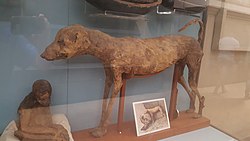| KV50 | |
|---|---|
| Burial site of animals | |
 Mummified dog and monkey (Egyptian Museum, Cairo) Mummified dog and monkey (Egyptian Museum, Cairo) | |
 | |
| Coordinates | 25°44′23.2″N 32°36′1.3″E / 25.739778°N 32.600361°E / 25.739778; 32.600361 |
| Location | East Valley of the Kings |
| Discovered | January 1906 |
| Excavated by | Edward R. Ayrton |
| ← Previous KV49Next → KV51 | |
Tomb KV50 is located in the Valley of the Kings, in Egypt. It was discovered in 1906 by Edward R. Ayrton excavating on behalf of Theodore M. Davis. Together with KV51 and KV52, it forms a group known as the "Animal Tombs". It contained the burial of a dog mummy and a mummified monkey and is probably associated with the nearby tomb of Amenhotep II (KV35).
Location, discovery, and contents

The tomb is located on the same rocky promontory as KV49, in the side valley that leads towards KV35. It is at a slightly higher level than KV49, and is located to the west of that tomb. KV50 was the first of a cluster of three tombs discovered by Edward R. Ayrton in his clearance of this part of the valley on behalf of Theodore Davis. The entrance was buried under 6 feet (1.8 m) of debris.
The tomb consists of a shaft, 12 feet (3.7 m) deep and 4 feet (1.2 m) square, which opens to the south onto a chamber 19 feet (5.8 m) long and 6–8 feet (1.8–2.4 m) wide. This was found partly filled with debris from the shaft.
Ayrton noted that the tomb had been thoroughly robbed in antiquity, though from the presence of wooden fragments it likely once held a coffin. No trace was found of the tomb owner's name. The only occupants of the chamber were two animal mummies, posed against one wall.
Propped up against the eastern wall was a large dog, quite perfect although stripped of its wrappings, and a monkey still partially wrapped.
The tomb, along with KV51 and KV52, seem to have formed a burial ground for royal pets.
Recent excavations
This area was excavated in winter 2009–2010 by a team led by Zahi Hawass and Ahmed el-Leithy in an effort to relocate KV50, KV51, KV52 and KV53. This excavation revealed Eighteenth Dynasty pottery, tools, and ostraca including figured examples which included a sketch of a seated queen presenting an offering, depictions of sexual scenes with women and animals, and cartouches of Ramesses II.
References
- "Theban Mapping Project: KV50". Retrieved 15 April 2021.
- ^ Davis, Theodore M.; Maspero, Gaston; Ayrton, Edward; Daressy, George; Jones, E. Harold (1908). The Tomb of Siptah; The Monkey Tomb and the Gold Tomb. London: Archibald Constable and Co., Ltd. pp. 16–17. Retrieved 15 August 2021.
- Reeves, Nicholas; Wilkinson, Richard H. (1996). The Complete Valley of the Kings: Tombs and Treasures of Egypt's Greatest Pharaohs (2010 paperback ed.). London: Thames and Hudson. p. 185. ISBN 978-0-500-28403-2.
- Spencer, Patricia (Autumn 2010). "Digging Diary 2009–10". Egyptian Archaeology. 37: 26. Retrieved 17 September 2021.
External links
- Theban Mapping Project:KV50 includes detailed maps of most of the tombs.